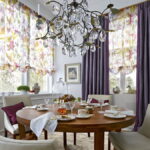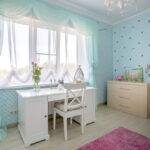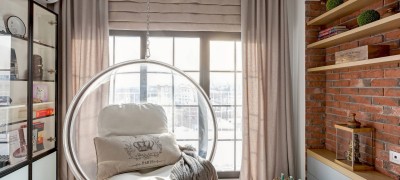Features of organza tulle
Modern tulle is a common type of curtain that allows you to simultaneously hide the contents of the room and give those in it a good view. Tulle is often made from organza, a lightweight and durable fabric with high decorative properties.

Feature of organza tulle
Organza has a thin, but strong enough structure, which makes the material weightless but durable. Decorativeness is provided by iridescent shining color and variability of appearance, since the fabric can be matte and shiny, smooth and with different kinds of work.

In the manufacture of fabric, the fibers are twisted in pairs, which allows you to form a dense, well-retaining the shape of the fabric. The shimmering effect is achieved by pre-cutting some of the threads on special machines.
Advantages and disadvantages
The advantages of organza curtains include the following:
- High density and stiffness. Thanks to this, the service life of the fabric can reach ten years without losing its appearance and shape.
- Good compatibility with most fabrics used for sewing heavy heavy curtains. Provided with a variety of colors and textures.
- Transparency and airiness. This allows her to let in a large amount of light.
- Crease resistance and resistance to dust accumulation. It is provided with a special arrangement of fibers and resistance to the accumulation of static electricity.
- High lightfastness. Allows tulle not to fade even on the sunny side.
- Light and air permeability. Thanks to this, natural air circulation is maintained in the room, and the light becomes brighter and diffused.
- Ease of care. The fabric can be easily washed from various dirt both by hand and in a typewriter.

Note! Organza tulle drapes well, which makes it possible to use it in the manufacture of lambrequins and other decorative elements.
Among the disadvantages of such curtains are:
- high cost due to the complexity of the production process;
- ease of formation of clues, which makes the choice of organza tulle undesirable for a home in which there are pets or small children;
- the tendency to form large creases that are difficult to smooth out, which is caused by strong twisting of the threads;
- the complexity of processing, since the fabric is difficult to cut and is capricious in sewing.

Note! Organza made of polyester does not form small folds on the windows.Because of this, this material is not recommended for small windows in small rooms.
Varieties
By materials used
Initially, organza was made from specially twisted silk threads, which were so thin that they seemed transparent. Such a fabric was expensive because it was difficult to obtain a natural fiber free from flaws. This luxury was available only to wealthy people.

Later, viscose and other synthetic materials were used for the production of organza, which made the cost much lower. Modern organza is made mainly of polyester, which makes it as affordable as possible, while maintaining quality characteristics.
Note! Organza tulle can be made of various materials, so before purchasing it is worth clarifying the composition.
Silk
Silk organza is a lightweight thin material made of natural silk by intricate weaving of strong fine threads that give the fabric a beautiful glossy shine. The resulting fabric is stiff, transparent and airy. The patterns used for decoration give a luxurious and sophisticated look to the fabric. Silk organza is softer and more pleasant to the touch than viscose or polyester counterparts. It goes well with other fabrics and lace, and can be dyed in any color.
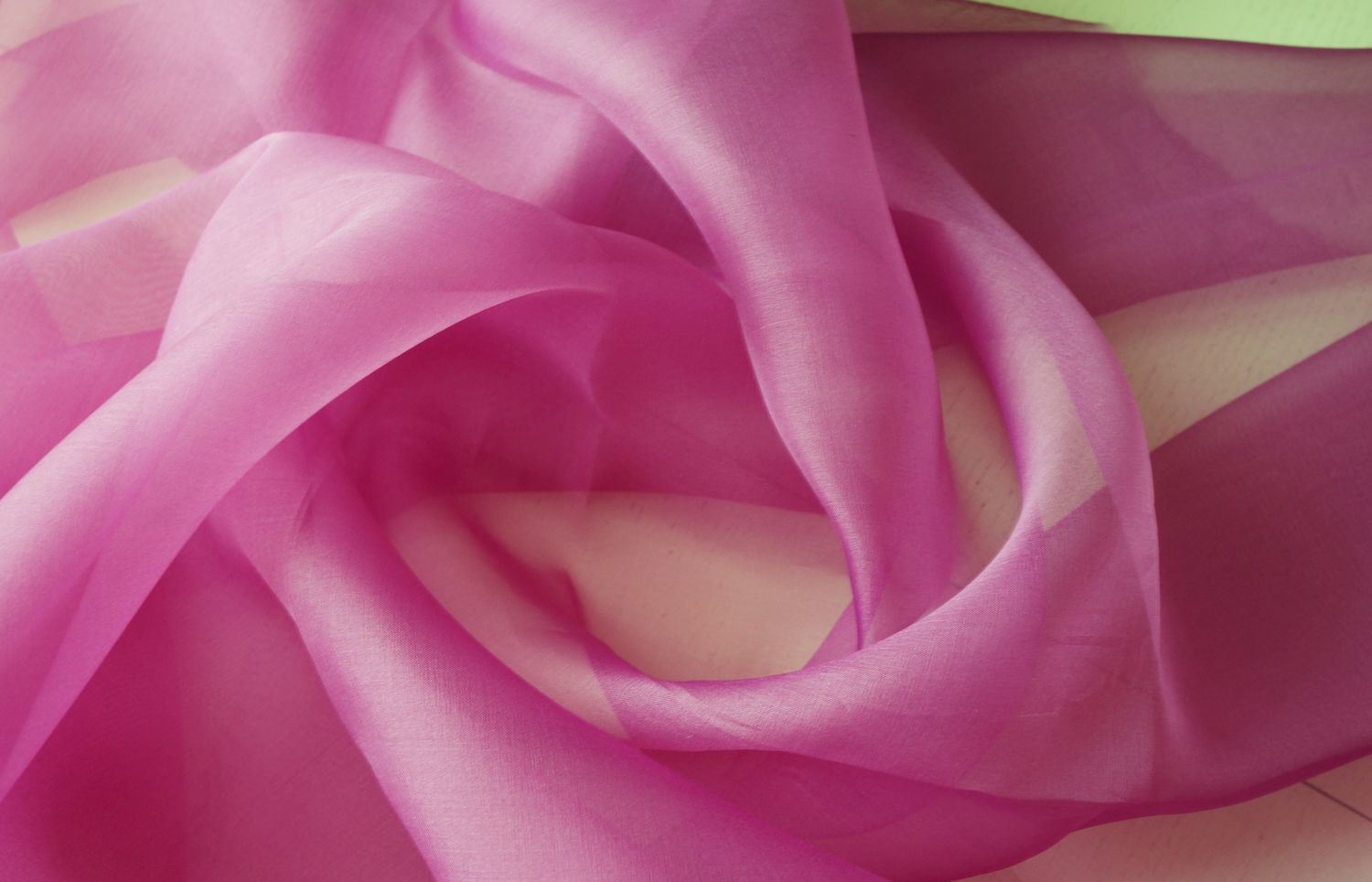
Viscose
The viscose fiber material is highly absorbent. Organza is rarely made from 100% viscose, as it wrinkles a little. Usually a small percentage of polyester is added to the composition, which gives the material good shape retention and a starched appearance. Viscose organza costs less than silk, but more expensive than polyester.
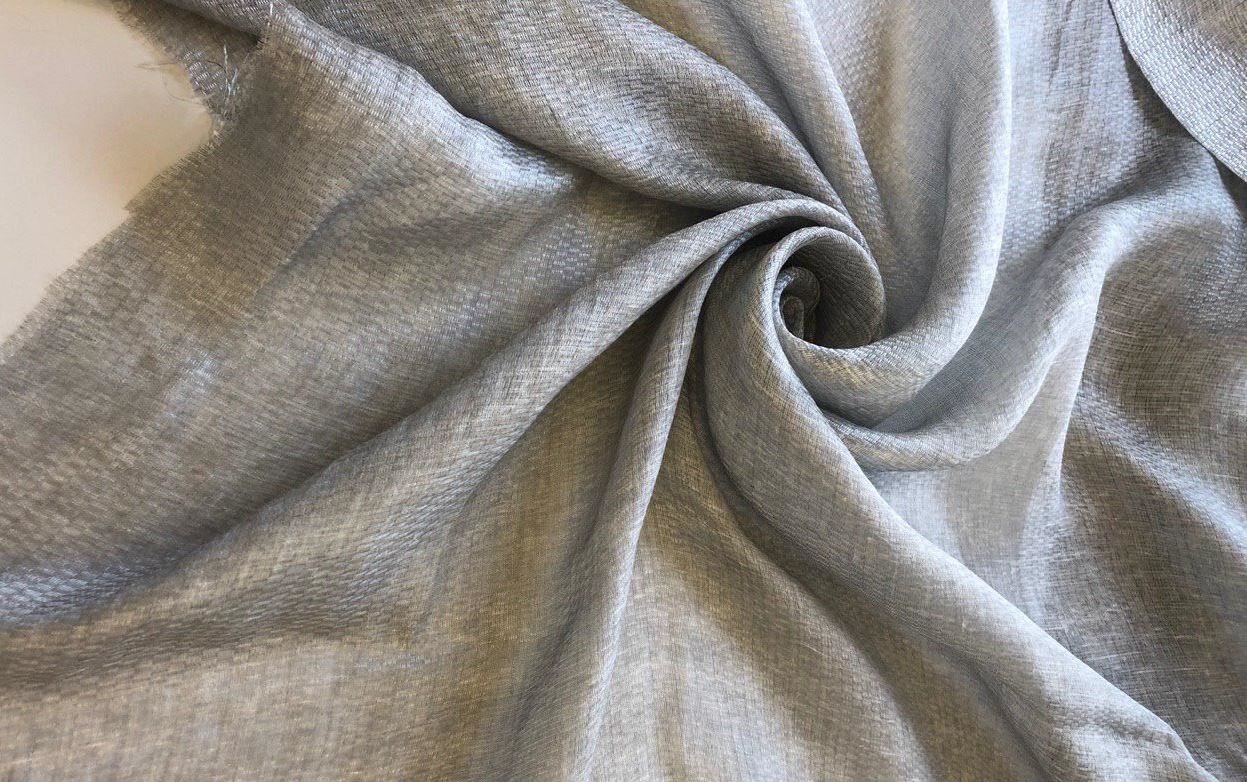
Viscose canvases are most often made in muted pastel colors, have colors with a plant motif or just an ivory shade. Such a tulle will be optimal for a room in Provence style or with ethnic motives.
Polyester
100% polyester is the most common fabric option. It does not wrinkle, holds its shape very well, is cheaper than its counterparts and can be subjected to various decorative processing methods.

Note! Since this fabric is not natural, it can cause allergic reactions.
By transferring colors
Matt
Such fabric reflects little light, which gives it a strict look. For this reason, the matte type of fabric is mainly used for interior decoration in a classic style.

Shiny
To give the surface a characteristic shine, a method of additional cutting of the fibers is used. The result is a glossy material characterized by iridescence and radiance, absorbing the sun's rays and sending them reflections to all corners of the room. Because of this property, shiny organza is used in dark rooms to make them lighter. This tulle looks good in avant-garde, hi-tech and techno interiors. In addition, it is suitable for creating an oriental aura.

Note! Aluminum fibers can be added to the fabric, providing not only a strong shine, but also increased strength of the material.
Chameleon
Such fabric is distinguished by a spectacular play of shadow and light, since it is able to change color depending on the angle at which the light falls. To achieve a similar effect, an interweaving of threads of different colors is used at the base of the organza.

By color palette
Organza is dyed according to the following scheme:
- "Cooking" the workpiece in a special apparatus for 40-50 minutes. During this time, the color grasps, and the matter acquires the required shade.
- Passing matter through cylindrical perches. This removes excess moisture from the fabric and smoothes it out.
- Drying the canvas. It is carried out in an oven at a temperature of about 100 degrees.
Monochromatic
The canvas can be painted in any color, which allows it to be used in a wide range of premises. Solid tulle is optimal for an interior that does not have a pronounced accent on any color.
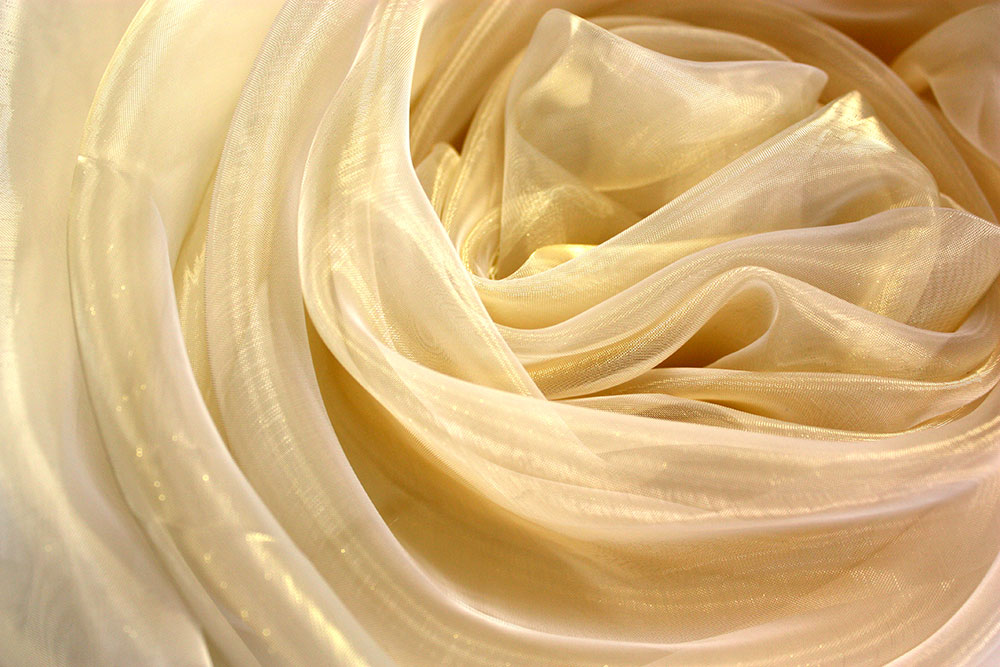
For a monochromatic organza, dusting is sometimes used, giving the tulle a golden or silvery sheen. Due to the shining particles, which is part of the canvas, this material looks very elegant, which makes it possible to use it in large festive living rooms.
Colored
Colored canvas, or organza-rainbow, is distinguished by the transition of one color to another. Multi-colored vertical stripes are applied to the fabric, which smoothly replace each other.

By decorative structure
Smooth
The classic version of organza. Transparent material with overflow on the bends, giving large elastic folds.

Harvested
It is a material with wrinkles and creases, making it softer than its smooth counterpart, gives softer folds and richer color due to less transparency. To achieve such a decorative effect, a special press is used during production.

By decorative elements
With print
To apply a pattern to the fabric, special rollers with patterns are used, which are used according to the following method:
- Installing the shaft into the machine. Each shaft is responsible for feeding a specific color. Ten or more such shafts can be installed.
- The movement of the fabric on the machine in the printing area. Gradually, she acquires the desired pattern.
- The arrival of the fabric in a large oven. There it is dried at high temperatures to secure the drawing tightly.
- Washing the fabric. Before applying the print, the organza is coated with a special compound for better adhesion, giving it a cloudy look. This coating is removed after printing.
- Drying and smoothing the canvas. These processes are carried out using special machines consisting of coils or rollers of different diameters and a drying chamber.
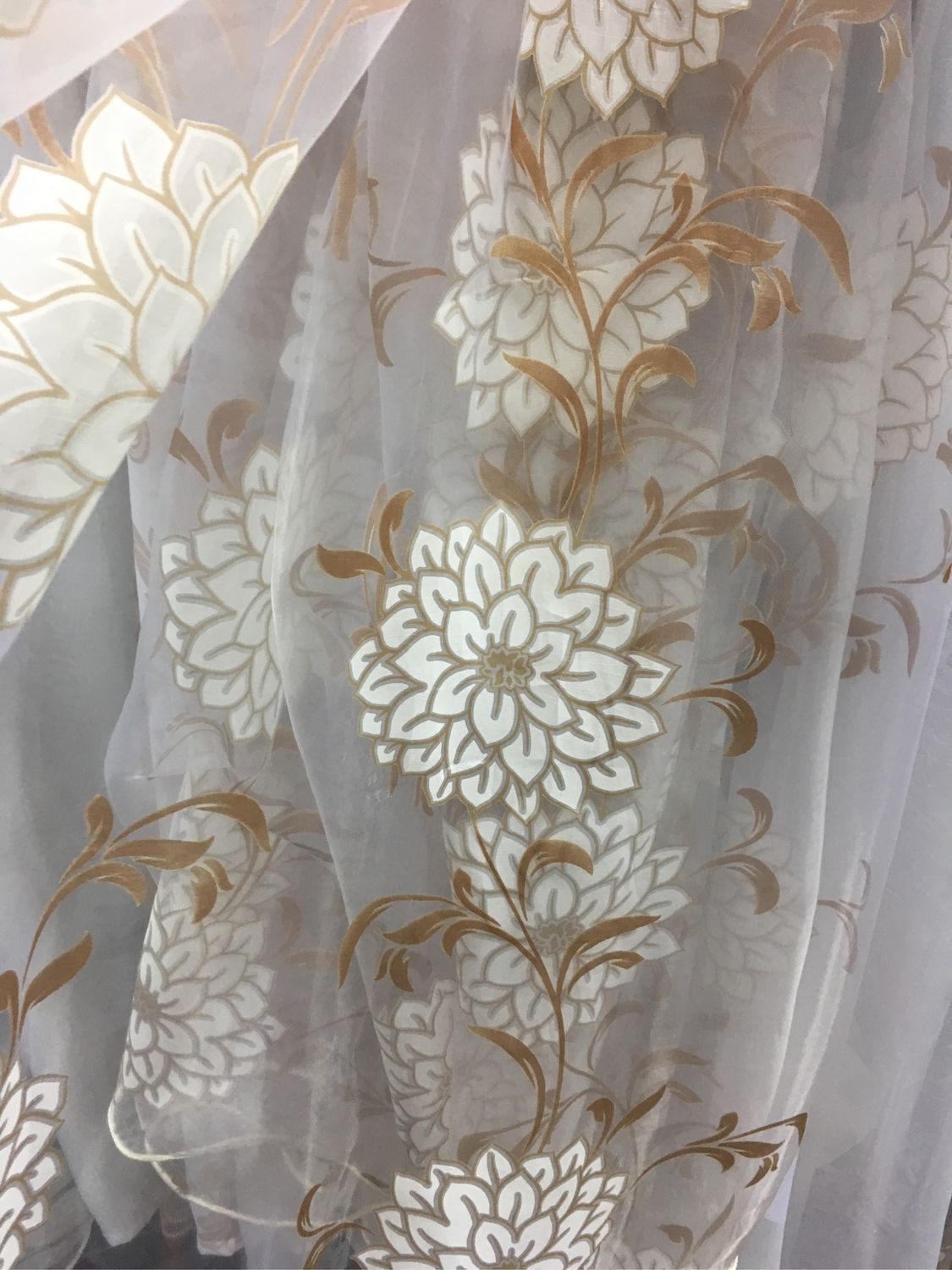
Note! The technology for applying patterns on clothing and on curtains is different, since each curtain material has its own specifics and turns out to be too rough or delicate for conventional printing methods on textiles.
With embroidery
Any kind of embroidery can be applied to the fabric - in the form of text, ornament, logo, drawing and more. Embroidery is used not only for artistic purposes, but also for creating corporate-style curtains. Tulle can be decorated with either hand or machine embroidery, and the second type is superior to the first in performance.
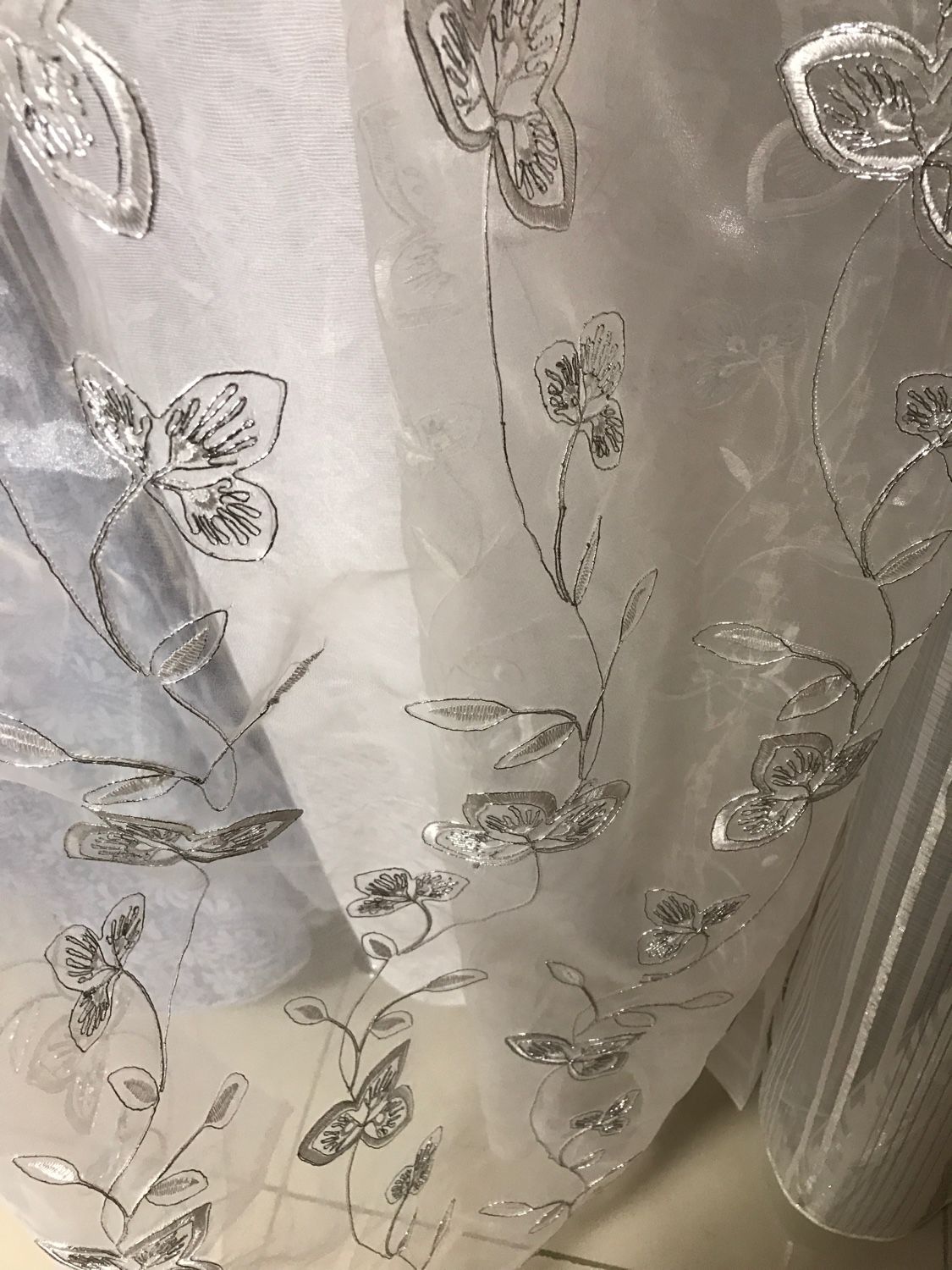
Perforated
This technique allows you to cut out the smallest intricate patterns on the canvas. The latter are created using vector graphics, after which decorative cuts are made on the fabric.

Jacquard
Jacquard fabric is a double-sided large-patterned material, during the creation of which hundreds of weft threads and warp are intertwined in a special way. Due to the complex structure of the fabric and the multi-stage technique of its production, the effect of a relief pattern is obtained. Usually jacquard fabrics are made from threads of several shades, differing in composition and properties. This allows you to form a multi-level image with multiple color transitions.

How to choose tulle
When choosing tulle, it is most convenient to build on the intended purpose of the room:
- Bedroom. Curtains with good air permeability and soft colors are suitable here. To create twilight, you can use tulle in blue, burgundy or pale green.
- Kitchen. For this room, organza is the optimal type of fabric, since it does not accumulate dust, it serves for a long time, is easily washed and does not fade in the sun. If the stove is located close to the window, then it is necessary to choose a short tulle to avoid fire. For the kitchen, it is best to use warm colors.
- Children's. Shiny organza will be a good solution for this room, as it will add light to it. At the same time, the tulle can be easily washed, which makes it quite practical.

How to sew organza curtains with your own hands
Selection of tools and material
First of all, you should decide on the required size of the curtains. If the future curtain is to reach the floor, then in finished form it must be made a little longer. Length measurements should be taken from hooks to floor level, adding a couple of centimeters. If you plan to hang the curtain on the lower hinges, then it is necessary to take into account its width, which can be proportionally larger.
To calculate the width of the curtain, the ratio with the width and the number of assemblies is used. The build ratio determines the number by which the width must be multiplied: 1: 1.5, 1: 2, or 1: 3. In this case, you should additionally add about 10 centimeters.

For work you will need:
- fabric of the required size;
- tape used for fastening curtains;
- binding of the same color as the base material, used to process the bottom edge;
- needles, threads, pins;
- sewing machine, pre-adjusted and tuned;
- scissors.
Important! The needles should be sharp to avoid damaging the fabric, and the threads should be strong but not very thick to ensure an even, beautiful seam.
Tulle sewing process
Sewing organza curtains with your own hands is carried out according to the following scheme:
- Measure the width of the window by multiplying the result by the assembly factor, and calculate the length by adding a few centimeters for future seams. To simplify the task, the fabric can be folded and ironed in the right place. This way you can achieve an even cut.
- Carry out cutting. This is the most difficult part of the job and requires extra care. An overlock can be used for side seams. If there is no special machine, then you can walk with a candle or a lighter along the edge of the curtain, taking precautions.
- Sew the edge. The usual machine stitching with a hem on organza does not look very attractive due to the nature of the fabric.In such a situation, you can trim the edge with hot scissors or a heated knife, holding the fabric at the cut with a metal ruler. In this case, the cut will not only turn out to be even, but will also seal the threads, preventing them from crumbling.
- Finish the bottom edge with a tape. The folds can be measured "by eye" or thoroughly ironed out beforehand. It is permissible to carry out processing with an overlock.
- Stitch the ribbon to the top edge of the tulle. It should be sewn just below the top edge to mask it. First, the upper part is attached, then the lower, previously pinned up.
- Pull and tie the ribbon cords. The ends of the cords do not need to be cut, even if they are too long, since the assemblies must be straightened before washing on a curtain with a ribbon.

How to use organza tulle in the interior
To decorate the window, tulle and veil royal patterns can be used as follows:
- in combination with Roman blinds;
- as an "independent" curtain, emphasizing the softness and airiness with the help of eyelets;
- in the form of a composition of several types of organza, differing in texture, pattern or color;
- in combination with massive cornices, soft and hard lambrequins;
- as curtains, in combination with various types of lifting and sliding curtains;
- in combination with any type of blinds - horizontal, vertical, with aluminum, plastic, fabric and wood slats;
- in the bedroom - in combination with a canopy over the bed of the same color;
- combining with decorative braid, ribbons or twisted cords with tassels, which will give solemnity and functionality;
- changing the arrangement of tulle and thick curtains so that the latter serve as a background for the drawing on organza.

Care rules
Organza care is quite simple, but the following nuances should be taken into account:
- washing should be carried out no more than three to four times annually;
- fabrics with beads, sequins and other decorative elements can be washed exclusively by hand;
- when washing in a washing machine, you should use a delicate mode and a temperature of no more than 40 ° C;
- special protective mesh bags should be used for washing;
- when washing with a machine, it is necessary to turn off the spin function, since twisting and strong spinning for the material is strictly prohibited;
- for washing, use liquid and low-foaming detergents, since powder particles are poorly washed out from the fiber structure;
- for bleaching, do not use aggressive and especially chlorine-containing agents, since they destroy the integrity of the fibers;
- bleaching of expensive organza varieties should be left to a professional dry cleaner;
- you should use at least a couple of rinses - in warm and cold water, to enhance the shine, you can add table vinegar;
- drying should be carried out in a completely flattened state, since in most cases this will avoid further ironing;
- during ironing, it is advisable to use attachments designed for delicate fabrics, or iron through gauze;
- during ironing, you must move the iron quickly.

Note! It is important to follow without fail all the care recommendations that are indicated on the organza tulle label or in the fabric catalog.
Before you sew organza tulle, you need to choose the appropriate size, color, texture and decoration of this fabric. With the right choice, you can very elegantly complement the interior, making it light and cozy.

Video: what is organza and how to sew tulle from it



